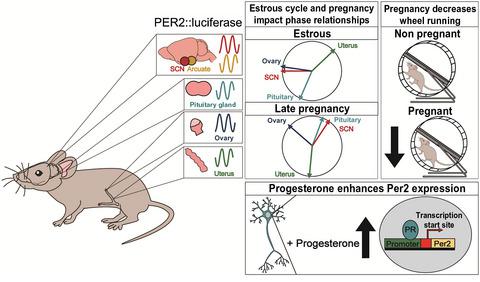当前位置:
X-MOL 学术
›
J. Neurosci. Res.
›
论文详情
Our official English website, www.x-mol.net, welcomes your feedback! (Note: you will need to create a separate account there.)
Circadian rhythms in the mouse reproductive axis during the estrous cycle and pregnancy.
Journal of Neuroscience Research ( IF 4.2 ) Pub Date : 2020-03-03 , DOI: 10.1002/jnr.24606 Alexandra M Yaw 1 , Thu V Duong 1 , Duong Nguyen 1 , Hanne M Hoffmann 1
Journal of Neuroscience Research ( IF 4.2 ) Pub Date : 2020-03-03 , DOI: 10.1002/jnr.24606 Alexandra M Yaw 1 , Thu V Duong 1 , Duong Nguyen 1 , Hanne M Hoffmann 1
Affiliation

|
Molecular and behavioral timekeeping is regulated by the circadian system which includes the brain's suprachiasmatic nucleus (SCN) that translates environmental light information into neuronal and endocrine signals aligning peripheral tissue rhythms to the time of day. Despite the critical role of circadian rhythms in fertility, it remains unexplored how circadian rhythms change within reproductive tissues during pregnancy. To determine how estrous cycle and pregnancy impact phase relationships of reproductive tissues, we used PER2::Luciferase (PER2::LUC) circadian reporter mice and determined the time of day of PER2::LUC peak (phase) in the SCN, pituitary, uterus, and ovary. The relationships between reproductive tissue PER2::LUC phases changed throughout the estrous cycle and late pregnancy and were accompanied by changes to PER2::LUC period in the SCN, uterus, and ovary. To determine if the phase relationship adaptations were driven by sex steroids, we asked if progesterone, a hormone involved in estrous cyclicity and pregnancy, could regulate Per2‐luciferase expression. Using an in vitro transfection assay, we found that progesterone increased Per2‐luciferase expression in immortalized SCN (SCN2.2) and arcuate nucleus (KTAR) cells. In addition, progesterone shortened PER2::LUC period in ex vivo uterine tissue recordings collected during pregnancy. As progesterone dramatically increases during pregnancy, we evaluated wheel‐running patterns in PER2::LUC mice. We confirmed that activity levels decrease during pregnancy and found that activity onset was delayed. Although SCN, but not arcuate nucleus, PER2::LUC period changed during late pregnancy, onset of locomotor activity did not correlate with SCN or arcuate nucleus PER2::LUC period.
中文翻译:

发情周期和怀孕期间小鼠生殖轴的昼夜节律。
分子和行为计时由昼夜节律系统调节,该系统包括大脑的视交叉上核 (SCN),该系统将环境光信息转化为神经元和内分泌信号,使外周组织节律与一天中的时间保持一致。尽管昼夜节律在生育中起着关键作用,但仍不清楚怀孕期间昼夜节律如何在生殖组织内发生变化。为了确定发情周期和怀孕如何影响生殖组织的相位关系,我们使用了 PER2::Luciferase (PER2::LUC) 昼夜节律报告小鼠,并确定了 SCN、垂体、子宫和卵巢。生殖组织 PER2::LUC 阶段之间的关系在整个发情周期和妊娠晚期都发生了变化,并伴随着 PER2:: 的变化。SCN、子宫和卵巢中的 LUC 期。为了确定相位关系的适应性是否由性类固醇驱动,我们询问黄体酮(一种参与发情周期和怀孕的激素)是否可以调节 Per2 荧光素酶的表达。使用在体外转染试验中,我们发现孕酮增加了永生化 SCN (SCN2.2) 和弓状核 (KTAR) 细胞中 Per2 荧光素酶的表达。此外,在怀孕期间收集的离体子宫组织记录中,黄体酮缩短了 PER2::LUC 周期。由于孕期孕酮显着增加,我们评估了 PER2::LUC 小鼠的跑轮模式。我们确认怀孕期间活动水平下降,并发现活动开始延迟。虽然 SCN,但不是弓状核,PER2::LUC 周期在妊娠晚期发生变化,运动活动的开始与 SCN 或弓状核 PER2::LUC 周期无关。
更新日期:2020-03-03
中文翻译:

发情周期和怀孕期间小鼠生殖轴的昼夜节律。
分子和行为计时由昼夜节律系统调节,该系统包括大脑的视交叉上核 (SCN),该系统将环境光信息转化为神经元和内分泌信号,使外周组织节律与一天中的时间保持一致。尽管昼夜节律在生育中起着关键作用,但仍不清楚怀孕期间昼夜节律如何在生殖组织内发生变化。为了确定发情周期和怀孕如何影响生殖组织的相位关系,我们使用了 PER2::Luciferase (PER2::LUC) 昼夜节律报告小鼠,并确定了 SCN、垂体、子宫和卵巢。生殖组织 PER2::LUC 阶段之间的关系在整个发情周期和妊娠晚期都发生了变化,并伴随着 PER2:: 的变化。SCN、子宫和卵巢中的 LUC 期。为了确定相位关系的适应性是否由性类固醇驱动,我们询问黄体酮(一种参与发情周期和怀孕的激素)是否可以调节 Per2 荧光素酶的表达。使用在体外转染试验中,我们发现孕酮增加了永生化 SCN (SCN2.2) 和弓状核 (KTAR) 细胞中 Per2 荧光素酶的表达。此外,在怀孕期间收集的离体子宫组织记录中,黄体酮缩短了 PER2::LUC 周期。由于孕期孕酮显着增加,我们评估了 PER2::LUC 小鼠的跑轮模式。我们确认怀孕期间活动水平下降,并发现活动开始延迟。虽然 SCN,但不是弓状核,PER2::LUC 周期在妊娠晚期发生变化,运动活动的开始与 SCN 或弓状核 PER2::LUC 周期无关。


























 京公网安备 11010802027423号
京公网安备 11010802027423号